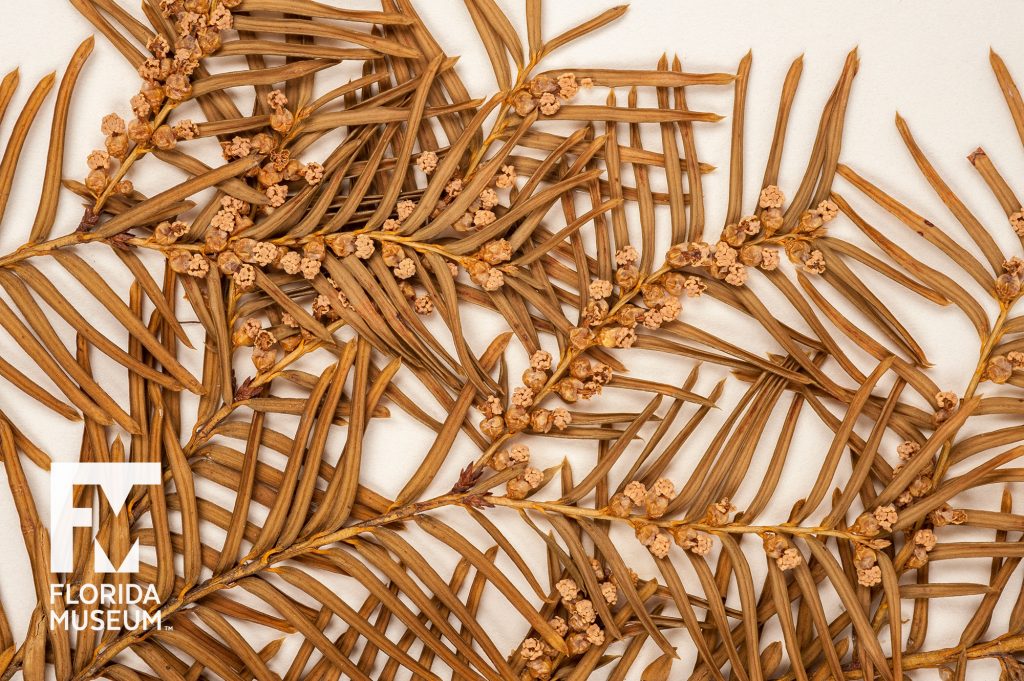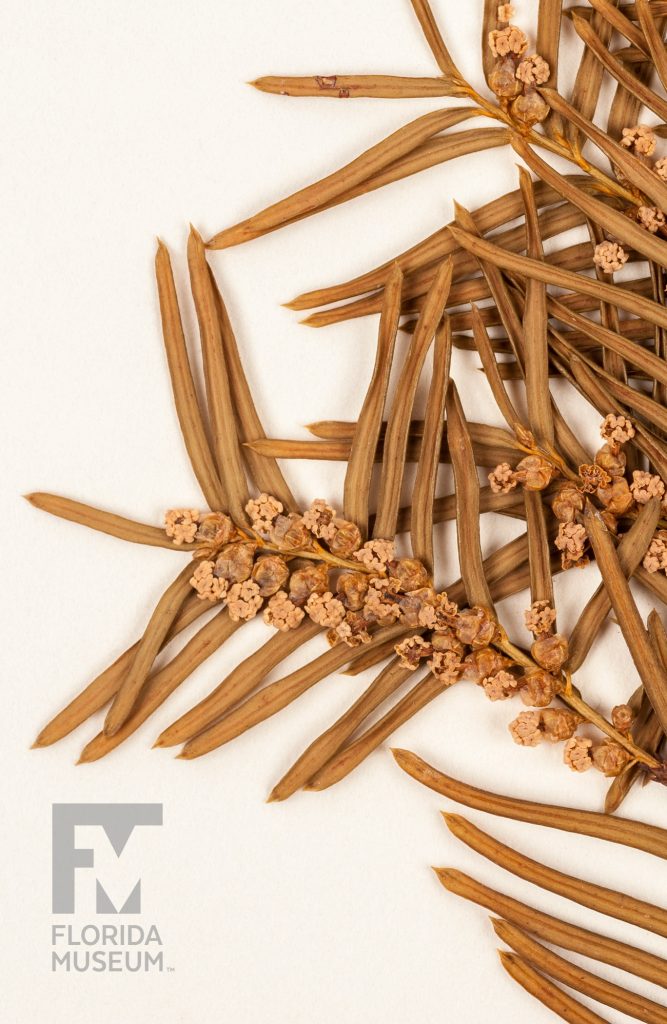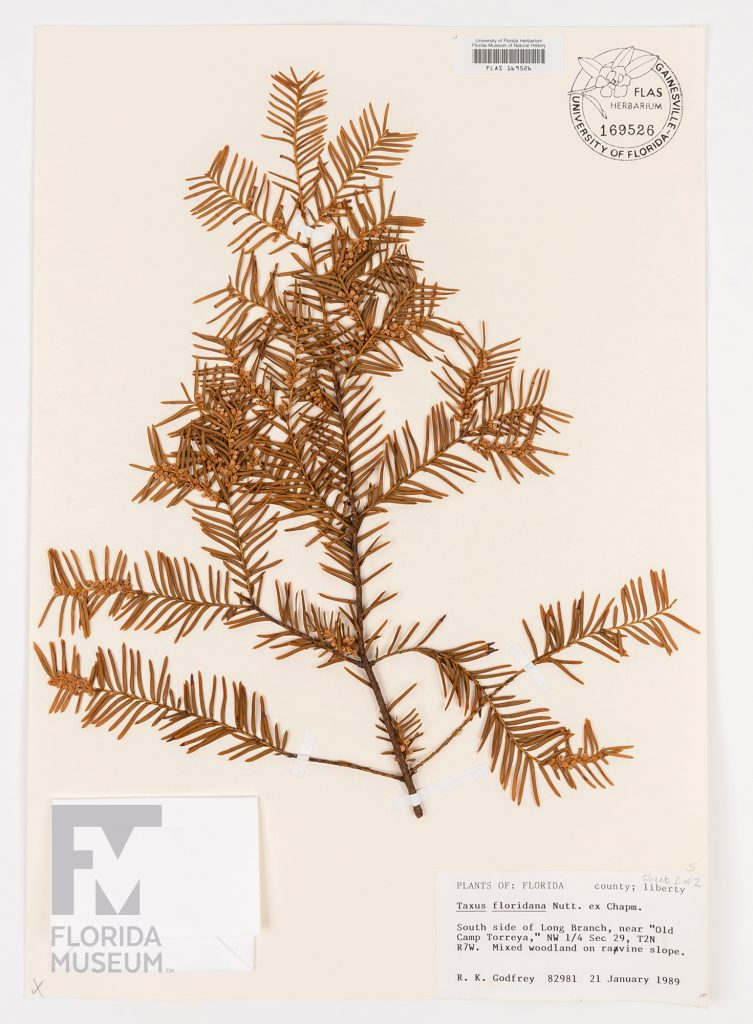This critically endangered native Florida plant produces Taxol, an anticancer drug. Florida yew is not harvested commercially due to its rarity. Taxol was harvested from several related wild species until scientists discovered how to synthesize the drug.
Summary
On Exhibit
Florida Yew (Taxus floridana)
From Alachua Co., Florida, Dec. 2016
Additional Website Photos
Florida Yew (Taxus floridana)
From Liberty Co., Florida, Jan. 1989
Collection
Story
This specimen of Florida yew is one of a few dozen stored in the University of Florida Herbarium. The sample was prepared by the Florida botanist Robert K. Godfrey in 1989. It documents the occurrence of this species at the location where it was collected and is used by researchers to study and describe the plant’s structures.
Florida yew is known by the scientific name, Taxus floridana. It is an extremely rare, evergreen shrub or small tree which generally grows from 10 to 20 feet tall. It occurs in the understory on bluffs and ravines in a less-than-4-square-mile area of the Florida Panhandle. Most of the approximate 20 known populations of this endangered species are within Torreya State Park and the Nature Conservancy’s Appalachicola Bluffs and Ravines Preserve. These preserves contain a moist, rich beech/magnolia forest. This habitat has sheltered quite a few other very rare species left behind after glaciation, including Torreya taxifolia, the Florida nutmeg tree.
Taxus floridana is a member of the genus Taxus. All species in this genus are commonly called yews. They are widespread across the Northern Hemisphere in North America, Europe and Asia, with quite a few small, isolated populations. As is all too common in our democratic profession, botanists can’t agree on how to divide the genus. Some treat Taxus as one species with many varieties, which would then be named after the oldest, Taxus baccata, the European yew. While others split it into as many as 24 species, the most accepted classification divides the genus into 10 species with four in North America including the Florida yew.
Florida yew is a conifer, which is the same major plant group as pines. It has flat, needle-like leaves arranged in two comb-like ranks on the branches. Plants are male or female. The specimen pictured is a male, which bears small flowers below the leaves. Female plants bear a fleshy cone which doesn’t look like a pine cone at all. It is light red, berry-like and almost completely surrounds a single seed at its tip.
The chemotherapy cancer drug Paclitaxel, or Taxol, was first developed from the bark of the Pacific yew. Florida yew also contains this compound, but it is too rare to be used as a source. There was concern that over-harvesting of the Pacific yew for this drug would endanger the species. However, there are now alternative methods to more efficiently produce the drug from cultivated yews.
Kent Perkins
Collection Manager, University of Florida Herbarium*
Florida Museum of Natural History
Exhibit
On display Sept. 23, 2017-Jan. 7, 2018, Rare, Beautiful & Fascinating: 100 Years @FloridaMuseum celebrated the Museum’s rich history. Each Museum collection was asked to contribute its most interesting items and share the stories that make them special. Though the physical exhibit is closed, this companion website remains online, providing an opportunity to experience the Florida Museum’s most treasured specimens.
Exhibit Area: Objects Tell Stories
Theme: Human Health
 Want to see more? Explore more than 300 breathtaking color photos of plants, animals, fossils and cultural heritage materials from the Florida Museum of Natural History’s collections in the award-winning book All Things Beautiful available from the University Press of Florida.
Want to see more? Explore more than 300 breathtaking color photos of plants, animals, fossils and cultural heritage materials from the Florida Museum of Natural History’s collections in the award-winning book All Things Beautiful available from the University Press of Florida.
*This title was accurate at the time the exhibit was on display in 2017. Please visit the collection website to verify current staff and student information.


